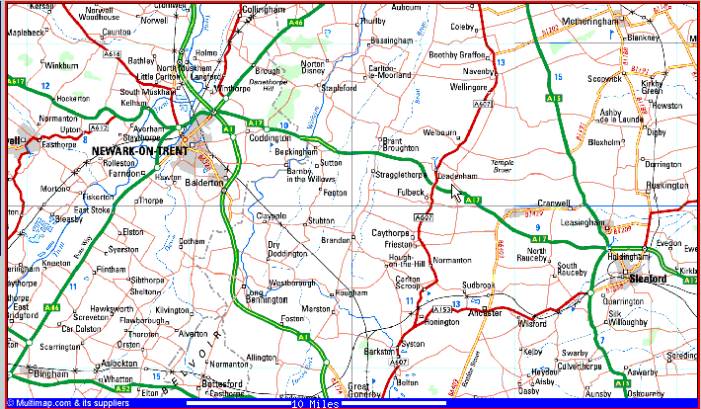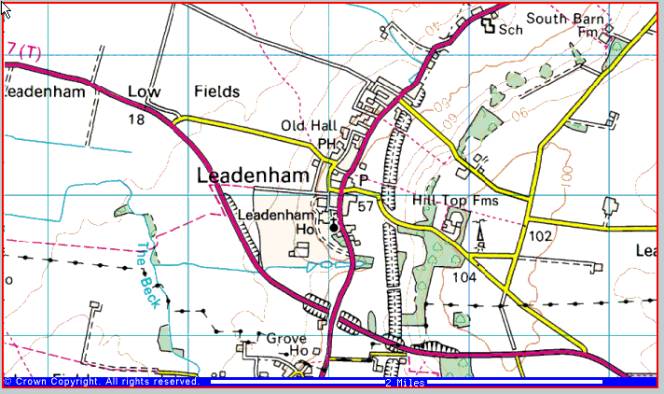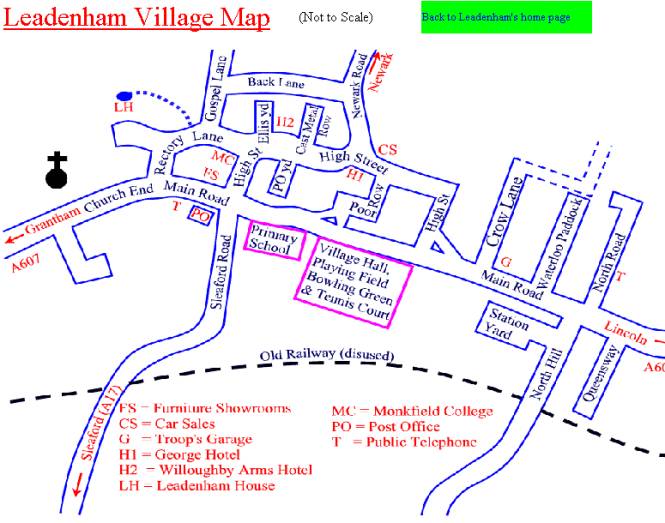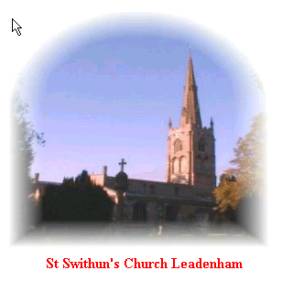 |
Source: Multimap.com
Theaker of Leadenham
Updated:
December 3, 2002
Hello Theaker Family Historians
I’m pleased to present Version 2 of the Leadenham Theaker Family Tree. It has grown considerably since October 2000 when Version 1 was presented on Steve’s website. I’ve been able to add all the 1901 census information, and included as much of the earlier census’s that I had available. There’s more to find, of course. Undoubtedly it will continue to grow as we discover new branches and add more information. I hope you will enjoy it and find something useful here.
There were several different reports I could have generated from my genealogy package, but in the end I selected two:
In all cases, I suppressed all information about living people except their names and spouse names. I even removed the phrase “still living” from the Descendant Chart that the package automatically created because I suspected it wasn’t right in some cases (how would it know?)
I’d be very pleased to hear from anybody (egelling@shaw.ca) who thinks they may be connected to our group of Theakers. We already have had occurrences of cousins discovering each other and setting up e-mail conversations amongst one another. It’s been fun.
I could also create some special reports for people who would like them, such as a sub-branch report.
I’d like to express special thanks to the people in our Leadenham & Liverpool Group: Ken Williams, Mona Timmis, Barbara Theaker, Rachel Theaker, and Pam Burgess. All five read through draft versions of their sub-trees to confirm I had it right, and each of them added some more to the tree. In addition, several other people have discovered this site and have made enquiries and contributions, which is much appreciated.
I must not forget to thank Steve Theaker for his site and his enthusiasm. This is the vehicle that lets us communicate, and it’s been a boon for Theaker research world-wide.
That’s about it for now. I’ll be keeping my computer file up-to-date as I find new information, and will be updating the site with a new version in a few months.
Sincerely,
Eric Gelling
Foreword
The THEAKER name originates from an Old Norse
word “thekja” meaning “to cover, one who roofs buildings”. It
then derived from the northern Middle English word “theke” meaning “to
thatch”. It would have
originated from the trade or occupation of the original bearer of the name,
probably back in the 11th or 12th century.
It has the same derivation as THATCHER, which is a much more common name
(having had one British Prime Minister with that surname, albeit her husband's
name). However, despite the Mormon
church having grouped them together in the International Genealogical Index (IGI),
the THEAKER’s and THATCHER’s have been quite distinct family names for many
centuries and shouldn’t be confused with each other.
The earliest THEAKER’s are found in the
north-east of England, specifically in Yorkshire, Nottinghamshire and
Lincolnshire. By the late 1700s and
early 1800s they had expanded to many nearby counties and beyond, and of course
are now located in all parts of the world.
The name as my family knew it is
pronounced “THEEKER”. I believe
in some areas it is pronounced “THAYKER”, but that could be a different line
of Theakers. I have heard
that the THAYKER pronunciation is more local to Yorkshire, whereas THEEKER is
Nottingham/Lincolnshire.
The spelling can vary, as with most surnames.
It wasn’t until the 1800s that the majority of people learned to read
and write, so the spelling of surnames became whatever the clerk wrote down from
what he heard. The spelling THEKER
was consistently used by my great-great grandfather and his brothers for a
period in the 1860s to 1880s, for some reason I can’t ascertain.
My interest in the THEAKER name comes from my
father’s mother. She was born
Margaret Radford THEAKER in 1880 in Liverpool, married William Charles GELLING
(a grocer) in 1902 in Rock Ferry, Cheshire, emigrated to Canada in 1910 and died
a widow in 1970 in Victoria at the age of 90.
I was her youngest grandchild, having been born when she was 65. I was
fortunate to have known her well. I
was 24 years old and she was 89 when we watched the moon landing together in
1969 (on her colour TV), and she reminisced about being already married when the
Wright Brothers flew the first plane.
I marveled at how much history she had seen, how much change she had
witnessed, and what a modern thinker she always was. Never greatly fond of young children, she loved
teenagers and young people in general, which was wonderful for me.
I have always been interested in genealogy.
I would ask both my grandmothers to tell me about their families, their
mums and dads, and grandparents. My
mum’s mother (who was from Cornwall) loved to talk about it, but my dad’s
mom was more reluctant. She
was the 5th of 15 children (12 of them girls, 8 of whom reached
adulthood), and often said one reason for coming to Canada was to get away from
all the sisters. But I know
she was fond of them (though one of them later told me she was “hard as
nails” to them), and one sister and one brother came to Victoria and lived
here also. Others came to visit
periodically, but she never returned to England.
To me, she was wonderful and I’d like to dedicate this work on the
THEAKER’s to her.
My grandmother’s father, John THEAKER,
was born in Leadenham, Lincolnshire in 1851.
He was a Commercial Traveller out of Birkenhead, had 15 children, and was
a fine and respected gentleman, very tall and stately. He lived to age 91, and his wife Margaret lived to be 88.
I have two pictures of him. He
has the “Roman Nose” that is apparently a characteristic of the Leadenham
Theakers.
John’s father Robert THEAKER had a varied
career, from being a labourer, cattle dealer, and innkeeper in Leadenham until
about 1860 when the family moved first to Salford and then to Liverpool.
There, he was a Coachman and Cab Driver.
His wife Mary RADFORD died in 1873 and Robert took up with a widow named
Harriet EASEY. He married Harriet
and they had a daughter Ada in 1880 when Robert was nearly 60.
Alas, poor Robert caught pneumonia in 1882 and died, and his widow
Harriet died 4 days later of pneumonia and “excessive grief”.
It is odd that nobody in my family knew or said anything about this new
family, but I found it on the 1881 census.
I wonder what happened to poor Ada, orphaned at two?
Going back further, we have John THEAKER
the publican of “Feathers Inn” in Leadenham.
He took over the pub in 1830 and held it until his death in 1846.
His widow Mary (nee FLETCHER of Brant Broughton) ran it until she died 10
years later. Then Robert ran it for a couple of years before giving it up
for a new career and life in Lancashire.
Reading between the lines of his epitaph and his death of liver disease,
it appears that John imbibed in the good stuff that he was selling perhaps more
than he should have. It
perhaps explains why his grandson (my grandmother’s father) never drank a
drop.
The first record of THEAKER in Leadenham
is the 1792 marriage of John THEAKER to Jane PUTTERGILL. This couple had a huge family, upwards of 17 children.
The records are confusing, and only about 13 of them can actually be
accounted for. I am reasonably sure
that the publican John is the son baptized in 1794 to this couple.
The only doubt comes from the entry of another John baptized in 1807. I have recently found a “Henry” in the 1881 census in
Yorkshire, born in Leadenham, who could match this 1807 entry, so it might have
been a transcription error (not uncommon in registers).
The original John Theaker of Leadenham was a
farm labourer, a very common occupation at that time. He died in 1830 “age 65” and left a short will.
His widow Jane died just before civil registration began in 1837.
The origins of both John and Jane are somewhat speculative. Jane may be the daughter of Henry PUTTERGILL and
Patience JACKSON in 1771 in Caythorpe, just a few miles from Leadenham.
I have always been concerned that none of the 17 children of John and
Jane were named Henry or Patience, but the recent finding of Henry helps with
this. So far, no other eligible
“Jane PUTTERGILL” has shown up.
Finding the origins of John THEAKER of
Leadenham is more of a challenge. There
are lots of John THEAKERs in the nearby areas in Lincolnshire and
Nottinghamshire. However,
I have narrowed it down to one good possibility.
That is the John, son of Thomas and Hannah THEAKER baptized in 1768 in
North Collingham, Nottinghamshire. I’ve
checked the registers of both North and South Collingham, and there is nothing
that would discount it (i.e., no burial entry, no contradicting marriage entry,
etc.). John named his first
son “Thomas”, which is a very positive clue though there is no “Hannah”.
After the father Thomas died in 1783, the family seems to have mostly
left except for a daughter Hannah who had an illegitimate son William in 1798.
This William (born in North Collingham) may be the one who shows up in
the 1841 and 1851 census’s in Carleton-le-Moorland, near Leadenham, and it was
this fact that first led me to search this parish.
If North Collingham is the correct
connection, then we can go back two generations.
Thomas was baptized in 1739, the son of another Thomas THEAKER and
Elizabeth. The elder Thomas
was buried in 1766 and Elizabeth in 1783, one week before their son Thomas.
I have been unable to find the marriages of Thomas to Hannah or Thomas to
Elizabeth. The film of parish
registers that I researched had gaps and was difficult to read, particularly
prior to 1720, so I cannot tell if the elder Thomas was from there or not.
However, there was a large family of Theakers there in the period
1625-1640, who could be the ancestors of our Theaker family.
The following documents are comprehensive
of everything that I have found, deduced and/or been given to me about the
descendents of John Theaker, farm labourer of Leadenham.
I have only printed up to the sixth generation, which is my father’s
generation. I have
three reasons for stopping there. The first reason is that my interest is much stronger in
finding the historical ancestors than finding all the living descendents.
The second reason is to be sensitive to the privacy of living people who
may not wish to have this information published.
The third reason is that it’s very incomplete and would be hard to
maintain as more and more Theaker babies are born.
Indeed, I don’t know all my cousin’s children’s children, and to go
back to my father’s 40-odd cousins (who he knew perhaps 4) is beyond my means
or capability.
In closing, I would like to give credit to
a number of people who, over the years, have provided so much valuable
information to me, without which this compilation wouldn’t be possible:
1.
My own family, including my grandmother Margaret, and three of her
sisters (Beatrice, Jean and Gertrude), Auntie Beaty’s daughter Audrey Steele
of Nanaimo BC, my father Bill and his brothers Jack, Harold and sister Peggy.
Other than Audrey, all are gone now.
I only wish I could talk to them some more.
2.
Dorothy and Ken Theaker of Scunthorpe, S. Humberside with whom I
corresponded in the mid-1980s, who diligently copied all the Leadenham registers
for Theakers, and sent me a great photo of Ken’s ancestors Henry Theaker
(brother of Robert, my 2xg-grandfather) and Jane Covel.
Descended from Henry Theaker (1832-1907), son of John the Publican.
3.
Dennis Theaker of Leadenham, who wrote to me several times around
1979-80. Dennis and his family
still live in Leadenham, representing a 200-year tradition. It was Dennis who gave me the inscription entry of the
publican John Theaker, pictures and postcards of Leadenham, etc.
Dennis is descended from Henry Theaker (1832-1907)
4.
Malcolm Lynaugh of Doncaster, S.Yorks, with whom I corresponded in
1979-80. Also descended from Henry.
5.
Graham Wallhead of Lincoln, Lincs who recently sent me a chart of the
descendants of Henry Theaker.
6.
Pat Morgan of Romsey, Hampshire who also sent me a Henry Theaker chart.
These two charts complemented each other because they focussed on
different sub-families.
7.
Ken Williams of Runcorn, Cheshire. Our
e-mail correspondence in early 2000 proved very fruitful, as he is descended
from my great-grandfather John’s brother William, known as “Uncle Willie”
to my grandmother.
8.
Barbara Theaker of Liverpool area. One
fateful day in 1984 I was visiting Liverpool, and made a phone call to a Theaker
in the phonebook. I wrote a letter
and heard nothing more for 16 years, until 2000.
Barbara found the letter and we found each other.
Barbara’s husband George is descended from John Theaker (1831-1904),
brother of Robert and Henry. We’re
still working on her tree.
9.
Mona Timmis. E-mail
correspondent, descended from William Theaker (b1801) son of John the Labourer.
We recently sorted out her connections, through Charles Theaker and
William Theaker, her grandfather.
10.
Several correspondents who have Theaker connections but we haven’t been
able to “bridge the gap” yet:
·
June & Lewis Bright of Bridgwater Somerset
(connected to the Theakers of Chard Somerset, who have been tracked back to
Gringley-on-the-Hill, Notts (not too far from our Theakers)).
·
Graham Caldwell of Langwarrin, Victoria,
Australia (also connected to the Chard Theakers; it was Graham who sent me a
series of diskettes of Theaker records, that have constantly been useful for
me).
·
Tony Burton of Stockport, another descendent of
the Chard Theakers.
·
John Theaker of Queensland, another descendent
of the Chart Theakers.
·
Steve Theaker of Keighley, W.Yorks, the author
and custodian of the THEAKER WEB site.
·
Howard Knight of Winscombe, Avon who sent me a
list of Quaker Theakers in 1984.
·
Derek Murphy of Norway, who is connected to
Edmund Theaker of Sherwood Forest b 1827; we corresponded in 1984.
·
Stanley Theaker of Barnet, Herts, who is
connected to William Theaker of Gainsborough b 1818; we corresponded in 1983.
·
Curates of Leadenham, Brant Broughton and other
parishes, and superintendents of Sleaford, Liverpool and elsewhere, with whom
I’ve corresponded from time to time over the years.
I must not forget the people of the Mormon
Church, who have provided so much information to genealogists everywhere. Most
of the register information has been obtained through them, for which we all are
very grateful.
This compilation is as accurate as I could make
it, given the information that I have. I
feel confident that the relationships are reasonable and correct, but there’s
bound to be some transcription errors despite my best efforts.
As I obtain more information, I’ll be
updating my Legacy 3.0 Family Tree and probably will re-issue this report at
some future date. I’d like
to include pictures, but currently I don’t have a working scanner.
For any corrections, updates, new
information, stories, pictures, etc., please email me at:
I hope you find this useful
Yours truly,
Eric Gelling
Victoria, BC, Canada
November 18, 2000
INFORMATION ABOUT LEADENHAM
The following was obtained from the Web page for
Leadenham Village:
http://www.oden.co.uk/leadenham/
Leadenham is a small village nestling on the
Lincoln ridge escarpment about 13 miles south of the city of Lincoln. The Church
of St Swithun's dominates the village skyline and, like most village churches,
St. Swithun's reflects the history of the village and the surrounding area. From
its Pugin roof timbers in the chancel, through its plague graves, to its records
of births, marriages and deaths throughout the ages, the story of St Swithun's
is both historic and interesting. A recent addition to the village skyline has
been the new Village Hall. Built with local money and grants, the Hall is now
one of the focal points of village social life. Although the Parish Council has
overall responsibility, it is the Village Hall Committee that make facilities
available for events ranging from productions by the Leadenham Players and
professional traveling groups through the annual Village Show to private
parties. The historic George Hotel and the recently renovated Willoughby Arms
Hotel complete the Village social scene. The village has a number of active
groups including Art Classes, a Bowls Club, the Leadenham Players and an Over
Sixties Club. In addition to some light industry, amenities within the Village
include a Primary School, a small Post Office shop and a garage.
Leadenham is approximately halfway between
Newark-on-Trent (in Nottinghamshire) and Sleaford, about 10 miles from each.
The population is about 400. It
is on the A607 to Lincoln and close to the junction with the A13 between
Newark-on-Trent and Sleaford. The
following map shows its location along with several nearby parishes, including
Brant Broughton, Wellingore, Caythorpe, Welbourne, and Carleton-le-Moorland.
Note Collingham on the top edge of the map, north of Newark-on-Trent.
North Collingham is the speculative parish where the original John
Theaker of Leadenham may have originated.

Source:
Multimap.com
http://uk.multimap.com/map/places.cgi
 |
Source: http://uk.multimap.com/map/places.cgi

Source:
Leadenham Village Web Page:
http://www.oden.co.uk/leadenham/
